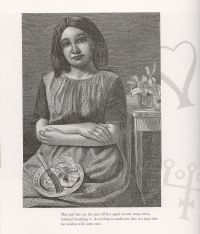| ________________
CM . . .
. Volume IX Number 19 . . . . May 23, 2003
excerpt:
Author, Candace Savage, has written five books for children as well as 15 for older readers. In Wizards, she writes in an informative way about wizards, alchemy, divination, astrology, and magic. Readers learn a lot about these topics. There is also a chapter on Isaac Newton, best known for his studies in physics and mathematics, but who, in his early years, practised alchemy. Wizards is well researched, scholarly and very interesting and could be used both as classroom support and recreational reading. It has a useful glossary, a list of other readings, an index and notes on sources. The text of Wizards could stand on its own. What make it almost irresistible are the numerous illustrations in both black and white and colour which are spread throughout the book. They are wonderful and make Wizards into a source of fun and entertainment. Spiders and assorted bugs, for example, appear in the most unusual places. So, too, do demons, witches and other peculiar creatures. Some are very strange indeed. These illustrations help to show just how superstitious western society was for so many centuries. A number are from the sixteenth and seventeenth centuries and indicate that, while Europeans were a religious people, religion did not have answers to all of their questions. If, for example, a scientist such as Isaac Newton, who is considered one of the greatest thinkers of all time, spent a large part of his life believing in wizardry and alchemy, one can imagine the feelings of the less well educated and more gullible of the population. These beliefs were only seriously challenged with the coming of the Age of Enlightenment in the eighteenth century. The popularity of Harry Potter seems to indicate that an interest in some of these superstitions remains. Highly Recommended. Thomas F. Chambers is a retired college teacher who lives in North Bay, ON.
To comment
on this title or this review, send mail to cm@umanitoba.ca.
Copyright © the Manitoba Library Association. Reproduction for personal
use is permitted only if this copyright notice is maintained. Any
other reproduction is prohibited without permission.
NEXT REVIEW |TABLE OF CONTENTS FOR THIS ISSUE - May 23, 2003. AUTHORS | TITLES | MEDIA REVIEWS | PROFILES | BACK ISSUES | SEARCH | CMARCHIVE | HOME |

